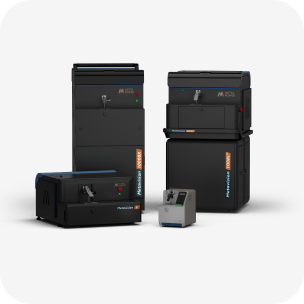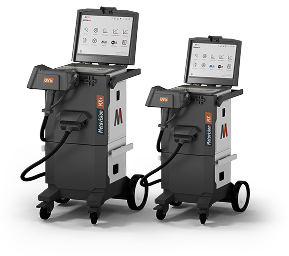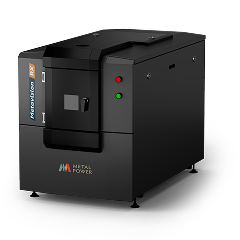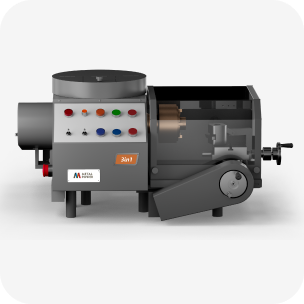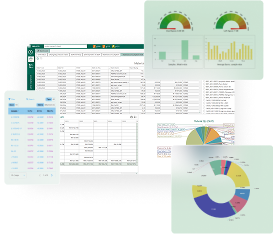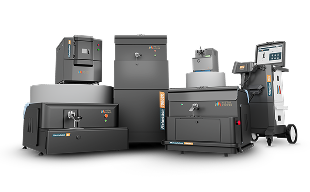Compare Models
Select maximum of 3 products to compare
Frequently asked questions
Products
About Spark Optical Emission Spectrometers
Benefits of Spark OES
Stationary Spark OES
Mobile Spark OES
Rotating Disc Electrode OES
Our Digital Products
About Metal Power Analytical
What is a Spectrometer, and why is it called that?
A spectrometer is a device that analyses a spectrum to generate outputs, such as the elemental concentration, molecular composition, etc., of the sample being analysed.
What is a Spark Optical Emission Spectrometer (Spark OES)?
A Spark Optical Emission Spectrometer, commonly referred to as just OES (also known as AES), is an analytical instrument that uses a high-current spark to excite a metallic sample, and then analyses the emission spectrum of the sample to identify and quantify the concentration of individual elements present in it.
What are the basic scientific principles that underpin an Optical Emission Spectrometer’s (OES’s) functioning?
An OES is based on two fundamental scientific principles:
- When an electron in an excited atom moves from a higher energy state to a lower energy state, it emits a photon. The wavelength of this emitted photon corresponds to the difference in the energy states.
- Each element has a unique set of wavelengths at which its atoms emit photons; in other words, each element has a characteristic set of emission wavelengths that uniquely identifies it.
What is the operating principle of an Optical Emission Spectrometer (OES)?
An OES applies a high-energy pulse train to the sample being analysed in an inert (Argon-purged) atmosphere, causing a part of the sample to vaporise and generate an emission spectrum. This spectrum is diffracted inside the instrument’s optics. The diffracted spectrum is captured by detectors that convert it into electrical signals, which are processed and analysed using computer-based algorithms, with the output being a report that provides the elemental composition of the sample.
What are the main parts of an Optical Emission Spectrometer (OES)?
While an OES has hundreds of individual parts, the most important modules are the Power Source, the Optics, the Data Acquisition System, and the Applications suite.
- The Power Source generates a high-energy digital pulse train that is applied to the sample in an Argon plasma. The energy from the pulses excites the atoms of the sample and leads to the generation of the emission spectrum, which then passes into the Optics
- The Optics form the heart of an OES. Light emitted by the excited atoms in the Argon plasma of the spark chamber enters the optics chamber. Here, it first falls upon a diffraction grating, which splits the light into its constituent wavelengths. This diffracted spectrum falls upon detectors that convert the incident light into currents, proportional to the intensity of the incident light, which is in turn proportional to the concentration of the emitting element, and feed this data to the Data Acquisition (DAQ) system
- The Data Acquisition System receives and processes the data captured by the detectors in the optics. This data is processed and converted into a form that is used for the generation of outputs by the Applications suite
- The Applications suite resides on a computer system that controls the entire spectrometer. It receives the data from the DAQ system and uses algorithms as well as a database of values based on Certified Reference Materials (CRM) to generate the outputs the user requires.
What are the uses of an Optical Emission Spectrometer (OES)?
The key uses for an OES include:
- Basic quality control tasks such as checking outgoing or incoming materials for compliance with grade/order specifications
- Optimising concentrations of expensive alloying elements in order to lower raw material costs
- Sorting of scrap based on grade and/or content of specific elements
- R&D purposes such as developing new alloys or assessing the impact of changes in composition on various material characteristics
What are the types of Spark OES available?
There are broadly two types of Spark OES – though of course, there are multiple product categories and variants within each type:
- Stationary or Lab OES: These are stationary models – benchtop or floor-standing, based on specification – that are designed to be used within Laboratories in controlled environments.
- Mobile or Portable OES: These models, as their name indicates, are designed to be used outdoors. They come equipped with mobility features, including handheld probes, integrated computers, wheels, and built-in batteries that allow them to be moved around at will and with minimal inconvenience.
How difficult is it to maintain and operate an OES?
OES are some of the simplest analytical instruments when it comes to operations and maintenance, since they come pre-calibrated (factory-calibrated) with all required analytical programs as well as a host of analytical features and an end-to-end diagnostic suite. These instruments are designed to be operable even by laymen with the most basic levels of training. Indeed, computer literacy is perhaps the only real qualification needed for a person to be able to operate an OES for basic usage.
How do you recalibrate a spectrometer?
Routine recalibration/re-standardisation of an OES is essential. As a general rule, this process should be carried out each time the operating environment changes. It includes:
- A change of the Argon cylinder
- Starting the unit after a shutdown
- A change in the base/matrix being analysed
What are the main benefits of using an Optical Emission spectrometer (OES) in manufacturing and quality control?
An Optical Emission Spectrometer (OES) helps manufacturers verify metal composition at various stages in the production cycle, including, but not restricted to, final product testing. The rapid in-process testing that an OES enables ensures that errors are corrected immediately and do not get detected only in the final stages of production. This reduces rejection/remelt rates and ensures that products meet specifications. Additionally, analytical tools with numerous features built into OES operating suites help in improving consistency in quality while also offering cost-optimisation upsides.
Why is an Optical Emission Spectrometer (OES) considered preferable for metal analysis compared to XRF?
Handheld XRF is portable and fast, but has multiple limitations. Most critically, these units can’t detect light elements with emission lines in the ultraviolet spectrum and therefore can’t analyse critical elements like Oxygen, Hydrogen, Carbon, Sulphur, Phosphorus and Nitrogen. Further, these units are also far less accurate and precise than OES. Spark OES is therefore the most preferred method for metal analysis as it offers far more accurate, precise and therefore reliable outputs for detailed composition analysis, particularly for ferrous metals.
How does an OES contribute to profitability and cost savings?
By allowing precise control over expensive alloying elements like Nickel (Ni), Chromium (Cr), and Molybdenum (Mo), manufacturers can reduce material costs without compromising on quality or price realisation by optimising the concentration of these elements while still meeting grade/specification requirements. Furthermore, the use of OES to validate the concentration in the melt helps eliminate the likelihood of non-compliance and/or rejection of materials. For a more detailed explanation of how an OES improves profitability.
Why is an OES preferred over ICP-OES or Mass Spectrometry for metal analysis?
When it comes to metal analysis, an OES offers multiple upsides over an ICP system. Some of the most critical ones are
- Factory calibrations: This ensures that an OES is usable for any and all samples in the bases/matrices it was ordered to analyse. ICP systems, on the other hand, need to be calibrated by the user for each type of sample, element, and range.
- Wide concentration ranges: An OES is designed to provide exceptional accuracy across a wide range of concentrations. An ICP system, on the other hand, works best when the user calibrates it for a narrow and specific range
- Analysis time: An OES provides results in ~30 seconds for most samples. Compared to it, an ICP system takes 30-60 minutes for each analysis (excluding calibration time)
- Startup and stabilisation: An OES stabilises after a cold start in 10-45 minutes (depending on model and hardware). An ICP system, on the other hand, can take hours for the plasma to stabilise
- Cost of operations: An ICP system consumes far more Argon and power, has a number of expensive consumables, requires repeated calibrations (and therefore expense on calibration CRM samples) and also requires highly trained chemists to operate it optimally. None of these is required for an OES, making the OES far more economical
- Productivity: As is evident, an OES provides exceptionally high productivity. Indeed, in several cases, an OES takes well over a thousand burns a day. This is simply not possible in an ICP system, making it infeasible for production environments
- Gaseous element analysis: ICP-OES do not match the gaseous element analysis capabilities of Spark OES. Hydrogen and Oxygen can’t be analysed at all on ICP-OES, while Nitrogen analysis too presents challenges and has severe limitations. Spark OES, meanwhile, offers exceptional results for all these elements.
What are the advantages of Spark OES over Wet Chemical Analysis?
Wet chemical analysis refers to the usage of empirical chemical testing methods. Such analyses are highly reliable, but Spark OES offers multiple advantages over Wet Analysis:
- Analysis time: An OES provides simultaneous analysis of 30+ elements per sample within a matter of seconds. Wet Labs use different test methods for the analysis of individual elements, and could take days to analyse all the elements that an OES covers. This alone makes Wet Analysis infeasible for the production shopfloor and would also lead to either a compromised set of elements analysed or a large build-up of inventory if Wet Analysis were to be used for final QC tests.
- Gaseous element analysis: Wet chemical analysis for gaseous elements in metals is considered suboptimal in most cases. Here, an OES offers tremendous upsides
- Operator-dependence: Wet analysis calls for highly-trained and specialised chemists, and also exceptional quality of the chemicals used in the analytical methods, whereas modern OES can easily be operated even by unskilled operators, once they’re trained on the basics of instrument usage.
- Productivity and cost:Wet labs offer far lower productivity and far higher operating costs as compared to OES
Which elements can the Metal Power Analytical’s Optical Emission Spectrometers detect?
Depending on the model, Metal Power Analytical Optical Emission Spectrometers can detect over 60 elements, including critical elements such as C, Si, Mn, S, P, Cr, Ni, Cu, Al, Zn, Pb, Sn, Ti, Mo, B, V, Nb, W, Co, Mg, gaseous elements like H, O, N and also ROHS elements (Pb, Hg, Cd). Further, higher-end models also offer Soluble-Insoluble analysis (differentiation of the acid-soluble and acid-insoluble components) of elements such as Al, Ti, Ca, and B.
Can a spark OES truly detect gaseous elements accurately?
Yes, an optical emission spectrometer can analyse gaseous elements with exceptional accuracy. This feature is available in all of our Metavision series spectrometers. The MOSS and Metavision-8i models offer Nitrogen analysis, while the Metavision-1008i3 and Metavision-10008X also offer Oxygen and Hydrogen analysis. The analytical outputs of all these have been validated not merely against certified samples (CRMs) but also with combustion analysers (CONH analysers). Should you wish to have more information about the specific detection limits and precision assurances, you could refer to our catalogues or reach out to our Sales or Marketing personnel at marketing@metalpower.net.
In short, the gaseous element analysis capabilities of Metal Power Analytical’s OES models can be summarised as follows:
In short, the gaseous element analysis capabilities of Metal Power Analytical’s OES models can be summarised as follows:
| Nitrogen | Oxygen | Hydrogen | |
|---|---|---|---|
| Metavision-10008X | Yes (Fe, Ni, Ti, Co, Zr bases) | Yes (Fe, Cu, Ni, Ti, Zr bases) | Yes (Ti, Zr bases) |
| Metavision-1008i3 | Yes (Fe, Ni, Ti, Co, Zr bases) | Yes (Fe, Cu, Ni, Ti, Zr bases) | Yes (Ti, Zr bases) |
| Metavision-8i | Yes | Not offered | Not offered |
| MOSS | Yes | Not offered | Not offered |
Which Metal Power Analytical spectrometer is best suited for high-end requirements?
For the most demanding requirements, we recommend our flagship model, the Metavision-10008X, which offers industry-leading analysis capabilities, especially for light and gaseous element analysis. For those seeking a more economical alternative, our upper mid-tier model, the Metavision-1008i3, also offers exceptional elemental analysis for virtually all industries and applications.
Which Metal Power Analytical spectrometer is best suited for small and medium foundries?
For small and medium foundries as well as other industries, the mid-tier model, Metavision-8i, is the most apt spectrometer solution. This model offers excellent analytical capabilities with segment-leading features at a budget-friendly price point.
How does the Metavision-10008X differ from the Metavision-1008i3?
The Metavision-10008X is Metal Power Analytical's flagship OES, engineered for ultra-low detection at single and sub-ppm levels across 60+ elements. While both the Metavision-10008X and the Metavision-1008i3 offer features like time-resolved spectroscopy, multi-stage argon repurification, and hermetically sealed dual optics, the former has higher reciprocal linear dispersion (RLD) owing to its larger focal length. This leads to it offering research-grade performance in terms of detection limits, accuracy and precision. While the Metavision-1008i3 is no slouch and offers performance that exceeds the requirements of most industry users, the Metavision-10008X is the model of choice for those who wish to operate at the cutting-edge of all operational and research applications. For a more detailed comparison between the two, you can visit our model comparison page.
Can the Metavision-8i handle multi-base analysis effectively?
Yes. The Metavision-8i is specifically designed for multi-base and multi-matrix applications. With dual optics and high-resolution CMOS detectors covering the full 140–620 nm wavelength span, it supports analysis across Steel, Cast Iron, Aluminium, Copper, Nickel, Zinc, and more. Its ability to detect deep-UV elements like Carbon, Sulphur, Phosphorus, and Nitrogen (as per ASTM standards) ensures reliable results in both ferrous and non-ferrous bases, making it one of the most versatile mid-segment OES solutions available.
What is the role of MOSS in entry-level spectrometry?
MOSS is Metal Power Analytical’s most compact and affordable stationary OES, designed as the ideal entry-level spectrometer for MSME units and first-time buyers in sectors like extrusion, rolling mills and other small or mid-scale manufacturing. Despite its small footprint, MOSS delivers accurate analysis of 30+ elements down to 50 ppm, with low argon consumption and high productivity. Modular and scalable, it enables businesses to adopt OES technology cost-effectively without compromising on reliability or compliance.
Do your OES systems support soluble-insoluble differentiation?
Yes, Metal Power Analytical’s advanced OES models, like the Metavision-10008X and Metavision-1008i3, offer soluble-insoluble differentiation. This feature allows users to distinguish between the acid-soluble and acid-insoluble forms of elements like Aluminium, Titanium, Calcium, and Boron in steels.
Does Metal Power Analytical offer sample adaptors with its spectrometers? How do OES adaptors expand testing capability?
Yes. Metal Power Analytical provides a wide range of precision-engineered adaptors with its OES systems. These adaptors allow analysis of non-standard sample geometries such as wires, rods, tubes, sheets, and small sections, with defined dimensional ranges. By ensuring a perfect fit and repeatability, adaptors expand the instrument’s analytical capability while maintaining accuracy and precision, making it possible to test a diverse array of metallic samples reliably. For more details, you can refer to the ecosystem section on each product’s respective webpages.
What other equipment and/or accessories does Metal Power Analytical provide to support OES usage?
In addition to Optical Emission Spectrometers, Metal Power Analytical offers a comprehensive range of allied equipment to enhance OES performance. This includes CleanSharp for electrode tip cleaning, eSharp for electrode sharpening in RDE systems, the 3in1 AFVS Sample Preparation Machine to prepare polished and ground samples for the best quality of analysis, WirelessRTDS for real-time result display at different locations, and ArmourSafe for protection from issues with the Mains power supply. Together with certified reference materials (CRMs) and sample adaptors, these accessories ensure accuracy, safety, and productivity throughout the analytical process. For more details, you can visit our Allied Equipment’s webpage.
Are your instruments capable of handling harsh environmental conditions?
This really depends on the type of spectrometer. Laboratory OES (stationary models) are designed to deliver the highest levels of accuracy and precision and therefore require a dust-free, thermally stable (air-conditioned) environment with exceptionally good input power supply, high-purity argon, and a setup that is free of vibrations. They can therefore not be used outside a controlled laboratory environment (as their name suggests). Mobile OES, on the other hand, are designed to be used in outdoor environments such as factory shopfloors, finished goods yards, and even scrapyards, and are specifically designed to be able to handle such harsh conditions, including temperatures ranging from as low as 5°C to as high as 50°C.
What is the key difference between the Metavision-MX and Metavision-MX+?
The primary differences lie in wavelength coverage and detection limits. The Metavision-MX+ spans 170–620 nm, covering 55+ elements, including Sodium and Lithium. The Metavision-MX, meanwhile, covers a range of 170–420 nm, analysing 50+ elements, making it ideal for most on-site PMI and sorting applications. Apart from this, the Metavision-MX+ also offers lower detection limits on the on-device optics than the Metavision-MX (the limits for the UV/UVis Smart on-probe optics remain the same across models). Both models share all other aspects, including the rugged designs, long battery life, multi-probe compatibility and integrated grade libraries.
How do mobile OES units like the Metavision-MX and Metavision-MX+ perform in scrapyards and shop floors?
The Metavision-MX and Metavision-MX+ are engineered for rugged, real-world conditions. With compact, trolley-based designs, they withstand shop floor temperatures of up to 50°C and deliver reliable results in challenging environments, such as scrapyards, recycling yards, and warehouses. Both models feature fast charging, long battery life, and multi-probe options for analysing ferrous and non-ferrous metals on-site.
How long can the Metavision-MX and Metavision-MX+ operate on battery power?
Both models offer up to 8 hours of continuous operation, featuring fast-charging technology that restores an 80% charge in under 10 minutes. This makes them highly practical for scrapyards, shop floors, and remote locations where uninterrupted testing is essential.
Are the Metavision-MX and Metavision-MX+ spectrometers easy to transport?
Yes, both models are designed as self-contained, modular trolleys with integrated computers and large touchscreens. They are compact enough to dismantle and fit into the boot of a standard-sized car or hatchback, with extendable conduits for flexibility, ensuring effortless mobility between locations.
Can your mobile OES systems analyse light elements like Carbon, Sulphur, and Nitrogen?
Yes, both the Metavision-MX+ and the Metavision-MX are compatible for usage with the UV or UVis Smart probes, which are optimised for deep-UV analysis, enabling detection of light elements such as Carbon, Sulphur, Phosphorus, Boron, and Nitrogen down to 20 ppm.
Do your mobile spectrometers include grade libraries for PMI and sorting?
Yes. Both the Metavision-MX and Metavision-MX+ come with a preloaded grade library of 350,000+ metal grades from 74+ countries, ensuring accurate Positive Material Identification (PMI) and grade sorting across global specifications. Users can also create custom libraries to match specific operational or regulatory requirements.
What industries benefit most from using mobile OES?
Mobile OES by Metal Power Analytical are particularly beneficial for scrapyards, recycling centres, metal traders, foundries, automotive manufacturing, and railways, where on-site analysis is critical. They help users sort materials accurately, verify compliance, and optimise raw material usage without depending on a stationary lab.
What is a Rotating Disc Electrode Optical Emission Spectrometer (RDE OES)?
A Rotating Disc Electrode Optical Emission Spectrometer is an analytical instrument used for oil and lubricant analysis, enabling condition monitoring of machinery and engines.
Which model does Metal Power Analytical offer for oil/lubricant analysis?
Metal Power Analytical offers Metavision-RX, an RDE-OES for predictive maintenance, wear monitoring, and lube oil analysis complying with the ASTM D6595 standard.
What makes the Metavision-RX stand out as an oil analysis spectrometer?
The Metavision-RX is a state-of-the-art, stand-alone Rotating Disc Electrode Optical Emission Spectrometer (RDE OES). It simultaneously detects up to 33 elements, including wear metals, contaminants, and additives in oils, coolants, heavy fuels, and other process liquids within 30 seconds.
How accurate is the Metavision-RX in detecting elements?
With its advanced multi-CMOS technology and automatic background correction, the Metavision-RX delivers exceptional accuracy, complying with ASTM D6595 and ASTM D6728 standards.
Who actually uses the Metavision-RX RDE OES?
Amongst a long list of clients, we see it widely used by railways, aviation fleets, shipping companies, mining operations, refineries, and heavy equipment operators. Basically, anyone who runs machinery where unplanned downtime can cost serious money and maintenance and condition monitoring requires swift and reliable solutions.
What makes the Metavision-RX different from other oil analysis tools?
It uses thermally stabilised CMOS optics and high-resolution gratings for consistent, repeatable results.
- Covers a broad wavelength range (165–800 nm) with provision to analyse Sulphur in oils/lubricants.
- Built with smart safety checks: sensors confirm electrodes, sample cups, and analytical gaps are all appropriately set before analysis starts.
- Achieves exceptional detection levels – meaning it captures even the slightest traces of wear metals or additives, differentiating them accurately from blanks.
How many elements can it actually analyse?
The Metavision-RX can analyse 33+ elements that include common wear metals like Fe, Cu, Cr, Ni, Pb, and Sn; contaminants like Na, K, Si, and Ca; and additives like Zn, P, Ba, and Mo. So, this comprehensive simultaneous analysis facility allows you to get the full health check for your machinery.
Is Metavision-RX RDE OES globally recognised?
Yes, the Metavision-RX complies with ASTM D6595 and ASTM D6728 methods, which are standard benchmarks for lubricant and oil testing worldwide.
How does Metavision-RX RDE OES compare with ICP-OES standards?
Metavision-RX RDE OES fully complies with ASTM D-6595 and D6728, and its results are directly comparable to ICP-OES methods like ASTM D5185, giving users the confidence of globally accepted accuracy.
What kinds of oils and fluids can it test?
Metavision-RX can analyse almost all the critical ones — lubricating oils, hydraulic fluids, turbine oils, etc.
How does the Metavision-RX help in preventive maintenance?
By picking up early signs of wear metals in oil samples, the Metavision-RX gives maintenance teams a heads-up before a machine failure. Think of it as an “early warning system” for your fleet or plant.
Is the Metavision-RX RDE OES complicated to use?
Not at all. The Metavision-RX is designed to be user-friendly with an in-house developed Analyst software suite. The automatic sensors ensure samples and electrodes are placed correctly, and our quick reference guides the user step by step to perform analysis. Once set, it’s a straightforward routine.
What makes it safe for operators?
The sample chamber door is equipped with sensors, and the instrument will not permit you to run an analysis unless everything is secure and in place. That reduces mistakes and ensures both operator safety and accurate analysis.
What consumables will we need?
We provide a starter kit which includes 1,000 graphite discs, 100 graphite electrodes, and 1,000 sample cups suitable for 1000 analyses. Over time, you’ll need to replenish these as part of routine use.
Any useful accessories?
Yes, we provide an electrode sharpener – the ‘eSharp’ – to maintain consistent electrode tips. There’s also a mobile application that displays the readings in real time and provides access to historical data. You can check details for both on the Metavision-RX product webpage.
Do Metal Power Analytical’s digital solutions support Industry 4.0 initiatives?
Absolutely, Metal Power Analytical’s digital suite – MetaLib Pro, MPALabTab, [FP]-LIMS, and FRP®.melt – are all built to support smart, connected, and automated Industry 4.0 workflows. They enable real-time data-driven decision-making, seamless system integration, better efficiency, and higher productivity across manufacturing ecosystems.
What is MetaLib Pro, and how does it support grade identification?
MetaLib Pro – powered by the Total Materia database – is a comprehensive grade identification library with over 350,000 metal grades and standards from 74+ countries. It enables instant verification and classification of metals by matching OES data against global standards, ensuring accurate PMI, compliance, and faster decision-making in production, procurement, and recycling environments.
Are updates and upgrades included for MetaLib Pro’s grade library?
Yes. MetaLib Pro receives regular updates to ensure sustained compliance with the latest standards, grades, and specifications. Updates are included as part of the product offering, ensuring users always work with the most current data for compliance and grade verification.
How does MPALabTab enable remote viewing of spectrometer data?
MPALabTab is a mobile and web platform that provides real-time remote read-only access to OES test results on any manner of device. It allows users to visualise results instantly, track historical logs, and generate SPC charts and infographics from anywhere, ensuring informed decision-making without being in proximity to the instrument.
Can MPALabTab be accessed across multiple devices securely?
Yes. MPALabTab is designed for secure, cross-device synchronisation across mobiles, tablets, and desktops. With encrypted data transfer and user-level authentication, it ensures spectrometer data can be accessed only by authorised users while maintaining full compliance with data security protocols.
What benefits does LIMS software integration offer in laboratory workflows?
Integrating [FP]-LIMS with OES workflows automates data capture from sample receipt to reporting. It enables the creation of integrated plans, workflows and reports across different types of instruments and tests, and also enables a clear audit trail for each sample. This integration therefore improves overall Lab efficiency by eliminating manual entries, ensuring complete traceability, eliminating missed tests and/or data entry errors, and enabling seamless workflow management across laboratories as well.
How does the charge correction platform optimise melting processes?
FRP®.melt optimises charge corrections by calculating the most cost-effective raw material addition required to meet composition targets. It ensures precise adjustments, reduces the cost of raw materials consumed, and also minimises waste, thereby increasing ROI.
What level of data security do MPA’s digital platforms provide?
All digital solutions by Metal Power Analytical are designed with robust encryption, role-based access control, and secure protocols. This ensures sensitive spectrometer and process data remain protected while allowing only authorised stakeholders to access results and reports. All of MPA’s solutions are also fully compliant with GDPR (General Data Protection Regulation) and ensure the highest levels of security and privacy.
Can MPA OES outputs also integrate with third-party systems?
Out of the box, MPA’s OES outputs integrate only with its own offerings (WirelessRTDS and MPALabTab) and specific approved partner offerings, such as FP-LIMS, MetaLib Pro and FRP®.melt. However, upon request, MPA can undertake add-on solutions to feed instrument outputs to databases, ERP systems or Lab/Foundry management systems used by the customer.
What sets Metal Power Analytical apart from other OES manufacturers?
Metal Power Analytical’s research and development, and product design philosophy have a simple guiding principle – we ensure that every model we make offers something that is a key value differentiator in the segment. So, be it Nitrogen analysis on an entry-level model (MOSS), dual optics in a lower mid-range model (Metavision-8i) or class-leading gaseous element analysis, each MPA model offers a unique advantage to users, that is not merely a feature, but something that genuinely adds value.
How long has Metal Power Analytical been serving the industry?
Metal Power Analytical has been at the forefront of elemental analysis since its incorporation in 1990. With over 35 years of continuous innovation, we have grown into a trusted global leader. We are proud to support our customers across various industries with robust, reliable products and exceptional service, building a legacy of excellence that spans more than three decades.
In which countries and regions does Metal Power Analytical operate?
MPA’s R&D, Production, and Corporate functions are headquartered in Mumbai, India, with regional offices in Singapore and the UAE. The company today has an expanding global footprint, serving customers directly and through partners in over 50 countries across six continents.
Which industries typically use Metal Power Analytical instruments?
Our instruments are essential for any industry where accurate metal analysis is critical. This includes foundries, steel plants, rolling mills, extrusion units and clients across key sectors like aerospace, automotive, energy, aviation and railways. Essentially, if you're involved in any application that produces, processes, or consumes metals, our instruments are designed to meet your needs.
How does Metal Power Analytical OES analysis support compliance with national and international standards?
Our OES systems are engineered to help you comply with a wide range of global standards. By providing accurate and precise analyses of critical alloying and trace elements, our instruments ensure your materials meet strict specifications for both domestic and export markets and meet the requirements of accreditation bodies and auditors.
Get in touch
Thank you for sharing your request. We have successfully received your details, and our team will contact you within 24 hours to discuss your requirements.
